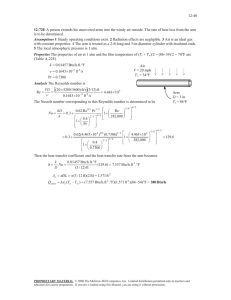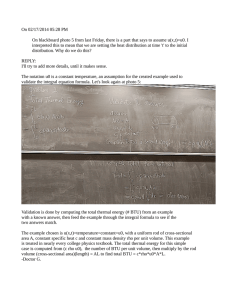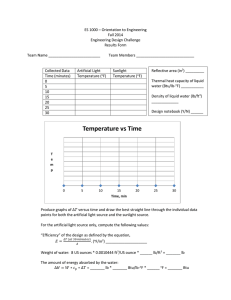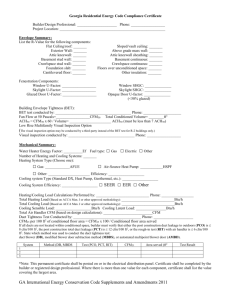HVAC Calculations and Duct Sizing
advertisement
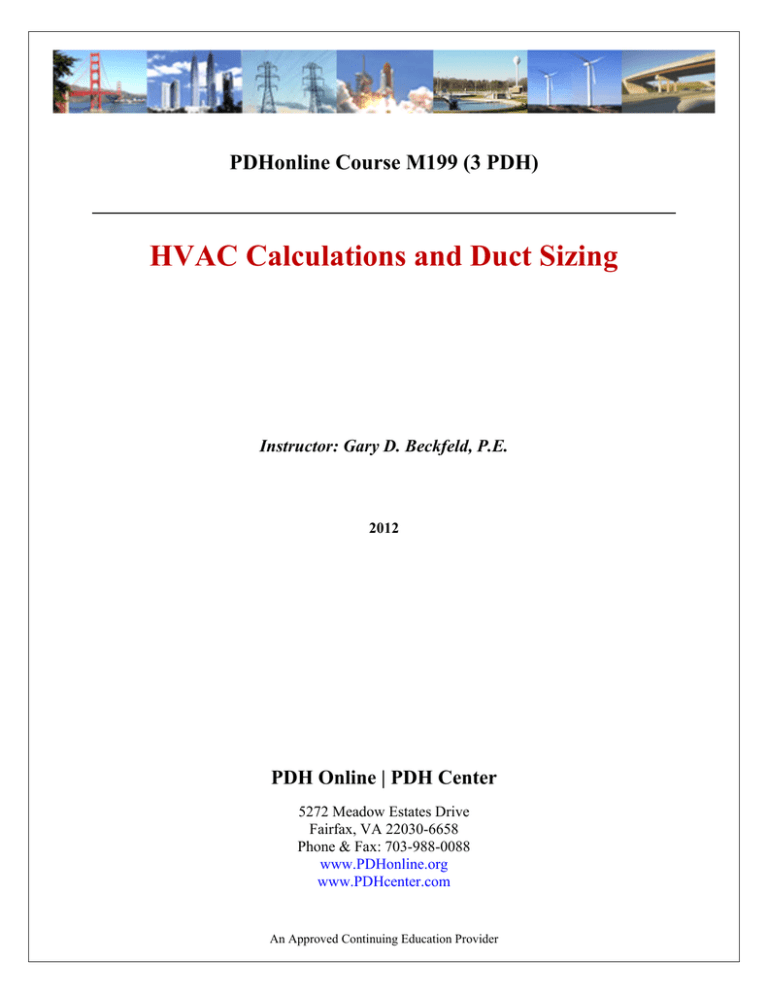
PDHonline Course M199 (3 PDH) HVAC Calculations and Duct Sizing Instructor: Gary D. Beckfeld, P.E. 2012 PDH Online | PDH Center 5272 Meadow Estates Drive Fairfax, VA 22030-6658 Phone & Fax: 703-988-0088 www.PDHonline.org www.PDHcenter.com An Approved Continuing Education Provider www.PDHcenter.com PDH Course M199 www.PDHonline.org HVAC Calculations and Duct Sizing Gary D. Beckfeld, M.S.E., P.E. COURSE CONTENT 1. Heat Conduction and Thermal Resistance For steady state conditions and one dimensional heat transfer, the heat q conducted through a plane wall is given by: q= kA(t1 - t2) L Btu hr (Eq.1) Where: L = the thickness of the wall in inches A = the area of the wall in square feet (t1 - t2 ) = temperature difference across the wall in degrees Fahrenheit k = thermal conductivity of the wall material Btu-in hr-ft2-F Equation 1 can be put in terms of a unit thermal resistance, R = L/k, or an overall heat transfer coefficient, U = 1/R, to give q= A(t1 - t2) R = UA(t1 - t2 ) (Eq.2) Note that the R in equation 2 is the factor often found on blanket insulation and other building products. Equations 1 and 2 are for a single material so the resistance R must be modified for building walls of several materials. 2. Building Walls Walls of buildings are constructed of several layers of different thickness, material, and area. Figure No. 1 shows a typical 2x4 framed house wall and a concrete wall with polystyrene insulation on both the interior and exterior surfaces. For the concrete wall, with the vinyl siding and drywall, there are © Gary D. Beckfeld Page 2 of 21 www.PDHcenter.com PDH Course M199 www.PDHonline.org five thermal resistance layers. In addition there are thermal resistances on the inside and outside surfaces of a building wall due to convective air currents and radiation. These resistances are accounted for with film coefficients, f, given by fi = 6.0 Btu/ (hr-ft2 -F) = 1/Ri inside surface with still air (Eq.3) fo = 1.63 Btu/ (hr-ft2 -F) = 1/Ro outside surface with moving air (Eq.4) Then for the whole concrete wall, the thermal resistance to be used in the conduction equation 2 becomes R = Ro +R1 +R2 +R3 +R4 +R5 +Ri (Eq.5) For the framed wall, similar thermal resistance equations would be written for the heat path through the studs and through the insulation path between the studs as indicated in Figure 1. q q q SIDING INSULATION CONCRETE INSULATION DRYWALL FRAMED WALL CONCRETE WALL FIGURE 1 In addition to the heat conducted through the walls, given by equation 2, a building can have heat gains or losses from the attic and basement. © Gary D. Beckfeld Page 3 of 21 www.PDHcenter.com PDH Course M199 www.PDHonline.org 3. Building Attic and Basement At equilibrium conditions, the heat loss or gain from the attic or basement, as indicated in Figure 2, is equal to the heat loss or gain to the building through the ceiling or floor. For an attic, equation 2 gives Ur Ar (to - ta ) = Uc Ac (ta - ti ) (Eq.6) Where r = roof properties, c = ceiling properties, a = attic properties a = attic temperature, o = outside temperature, and i = inside temperature. Solving equation 6 for the attic temperature gives ta = (Ur Ar to +Uc Ac ti ) / (Ur Ar + Uc Ac ) (Eq.7) After the attic temperature is found from equation 7, the heat conducted to the building through the ceiling can be found from equation 6. This procedure can also be used to estimate a basement (or attached garage) temperature and heat loss or gain to a building through the floor or wall. q q FIGURE 2 © Gary D. Beckfeld Page 4 of 21 www.PDHcenter.com PDH Course M199 www.PDHonline.org 4. Building Heat Loads The total cooling or heating load of a building consists of two parts, the sensible heat, Qs , and the latent heat, Ql . The sensible heat load comes from the following sources: 1. Heat conducted through the building (walls, ceiling, floor, windows). 2. Internal heat from lights, computers, ovens, and other appliances. 3. Infiltration of outside air through cracks around windows and doors. 4. People in the building. 5. Sun radiation through windows. The latent heat load to a building comes from the following sources: 1. 2. 3. 4. People in the building. Infiltration through cracks, chimneys. Gas appliances, range, ovens. Dishwasher, other appliances. The sensible heat load results in an air temperature rise in the building. To maintain temperature requirements, the air in the building is circulated over a cooling coil at a certain rate determined from the equation Qs = 1.1 (w) (ts -ti ) Where (Eq.8) w = cubic foot per minute of air circulation flow i = denotes inside air temperature s = denotes supply temperature of the air The latent heat load determines the amount of moisture that is added to the air in the building and must be removed from the air by the cooling coil to maintain humidity requirements. This is found from the equation Ql = 4840 (w) (Gs - Gi ) Where (Eq.9) Gi = pounds of moisture per pound of air in conditioned space Gs = pounds of moisture per pound of a supply air © Gary D. Beckfeld Page 5 of 21 www.PDHcenter.com PDH Course M199 www.PDHonline.org Once the sensible heat, Qs , and latent heat, Ql , are known, a sensible heat ratio, SHR, can be found from SHR = Qs / (Qs + Ql ) (Eq.10) The sensible heat ratio is useful in finding G, the moisture content of air, at different conditions using a psychrometric chart. 5. Psychrometric Chart A psychrometric chart is a graphical representation of the properties of moist air and is a useful tool in air conditioning calculations. This chart can be viewed online and a copy can be printed out from the following website: http://www.heatpipe.com/ProductsServices/forengineers/psychrometric_chart.pdf . Figure 3 is a sketch of an air conditioning cycle plotted on a psychrometric chart. The numbered points on the diagram correspond to the numbered points in Figure 4, a sketch of a building air conditioning system. These points are determined in the air conditioning calculations. 33.2 75 MP TE 25.8 5 59 3 DP .012 4 65 80 .81 .011 2 1 SHR Y LP G MOISTURE A TH EN 50% RH .0102 95 TEMPERATURE DB FIGURE 3 © Gary D. Beckfeld Page 6 of 21 www.PDHcenter.com PDH Course M199 1 www.PDHonline.org REHEATER BUILDING 35 X 73 5 80DB, 50%RH 4 COIL COMPRESSOR 2 15% MAKEUP 3 95DB,75DP 15% EXHAUST FIGURE 4 6. Air Conditioning Calculations Example A building, 35 feet wide and 73 feet long, is constructed with the type of concrete wall indicated in Figure 1. The concrete is 4 inches thick and the polystyrene insulation is 2 inches thick on each side. The east and west walls each have two windows. The north wall has 6 windows and the south wall has 9 windows. All windows are 2.5 feet by 4 feet. The roof and ceiling are frame construction. The conditions inside are to be maintained at 80 F db (dry bulb) temperature and 50% relative humidity. The outside conditions are 95 F db and 75 F dp (dew point) temperature. The cooling load in tons is be found for selecting cooling and air handling units. For ventilation, it is assumed the air handler will take 15% of the required flow from the outside conditions. Supply air in the building is to be 65 F db. Some thermal conductivities, k, and thermal resistances, R, of building materials for this problem are shown in Table 1. Where the overall heat transfer coefficient, U, is given, it is assumed to include film coefficients. More extensive lists of these values are found in References 1 and 2. © Gary D. Beckfeld Page 7 of 21 www.PDHcenter.com PDH Course M199 www.PDHonline.org TABLE 1 Material Siding Polystyrene Concrete Drywall Pine 2x4 Insulation Sheathing .5 in Glass Framed Ceiling Framed Roof k Btu-in/(hr-ft2 -F) R (hr-ft2 –F)/Btu U Btu/(hr-ft2 –F) 1.0 .17 10 .45 .8 .28 .8 1.13 .23 .22 Using Equation 5, the thermal resistance of the 4 inch concrete wall with 2 inch insulation is 1 2 4 2 1 R = 6 +1.0 + .17 + 10 + .17 +.45 + 1.63 = 26 (hr-ft2 –F)/Btu Equation 2 gives the heat conducted through the wall area minus the window area assuming 8 foot high walls. East wall West wall North wall South wall q = ((8x35) -2(2.5x4)) (95 -80) / 26 = 150 Btu/hr q = ((8x35) -2(2.5x4)) (95 -80) / 26 = 150 Btu/hr q = ((8x73) -6(2.5x4)) (95 -80) / 26 = 302 Btu/hr q = ((8x73) -9(2.5x4)) (95 -80) / 26 = 285 Btu/hr There are 19 windows with 10 ft2 each for a total glass area of 190 ft2 . The heat conducted through the glass is given by equation 2 as q = 1.13 (190) (95 -80) = 3220 Btu/hr Also for single sheet of unshaded glass, the radiation heat gain can be significant. This heat gain can be found from the equation q = A (SC) (SCL) Btu/hr © Gary D. Beckfeld (Eq.11) Page 8 of 21 www.PDHcenter.com Where PDH Course M199 www.PDHonline.org A = glass area in ft2 SCL = solar cooling load in Btu/ (hr-ft2 ) SC = shading coefficient assumed 1.0 for no shading Reference 1 indicates that for south facing windows, depending on the latitude, the solar cooling load can be nearly 100 Btu per hr per sq ft and nearly twice that for glass facing east or west. Then the radiation heat gains for this building are, from equation 11 East facing glass West facing glass South facing glass q = 20 (200) = 4000 Btu/hr q = 20 (200) = 4000 Btu/hr q = 90 (100) = 9000 Btu/hr For heat conducted through the ceiling from the attic, the attic temperature is found from equation 7. Assume the roof pitch is 30 degrees and using data from Table 1 gives ta = .23(2555)(80)+.22(2950)(95) = 88 F .23(2555)+.22(2950) Then from equation 6 the heat from the attic is q = .23 (2555) (88 – 80) = 4701 Btu/hr To account for infiltration of outside air through cracks around windows and doors, a leakage rate of 20 cubic foot per minute assumed. The resulting sensible heat gain inside is given by equation 8 as q = 1.1 (20) (95-80) = 330 Btu/hr For the heat gain from electrical appliances and lights, Reference 2 gives the equation q = 3.42 (Wattage) (Eq.12) For the medium size building considered here, Reference 1 gives an average electrical usage of 1.0 watts/ sq ft. This gives a heat gain of q = 3.42 (1.0) (2555) = 8738 Btu/hr © Gary D. Beckfeld Page 9 of 21 www.PDHcenter.com PDH Course M199 www.PDHonline.org Human occupants of the building contribute sensible heat according to their activity. From Reference 1, 200 Btu/hr per person is estimated for light activity. For two people in the building, this gives a heat gain of q = 2 (200) = 400 Btu/hr Adding all the heat gains from conduction and internal sources gives Total sensible load Qs = 35274 Btu/hr Human occupants also contribute to the latent heat gain in the building. For light activity people produce a latent gain of about 180 Btu/hr per person so this heat is q = 2 (180) = 360 Btu/hr The assumed infiltration of 20 cubic foot per minute of outside air brings latent heat into the building which is given by equation 9 as q = 4840 (20) (G3 - G2 ) where the quantities G3 and G2 are the moisture content of the outside and inside air respectively. Referring to a copy of a psychrometric chart or to Figure 3, locate point 2 representing the inside design conditions of 80F db and 50% relative humidity. From point 2, project a horizontal line to the right to the moister content scale and read and read G2 = .011 lb moisture per lb dry air. Similarly locate point 3 for the outside conditions of 95 F db and 75F dew point. From the chart obtain G3 = .019 lb moisture per lb dry air. Then the latent heat from the infiltration is q = 4840 (20) (.019 - .011) = 774 Btu/hr Appliances such gas ovens, ranges, and dishwashers add to the latent heat load in a building. These contributions are estimated from the data of Reference 2 as follows: Dishwasher Gas oven Gas range © Gary D. Beckfeld q = 420 Btu/hr q = 1200 Btu/hr q = 5600 Btu/hr Page 10 of 21 www.PDHcenter.com PDH Course M199 www.PDHonline.org Adding the latent heat gains gives Total latent load Ql = 8354 Btu/hr With the sensible and latent heat loads determined, equations 8 and 9 become 35274 = 1.1 (w) (t2 -t1 ) 8354 = 4840 (w) (G2 -G1 ) The first of these equations determines the flow rate, w, required of the air handler. The temperature t2 is the inside design condition 80F and t1 is the desired supply of 65F air at the outlet of the air handler. The flow rate is w = 35274 / ((1.1) (80 -65)) = 2137 ft3 /min The second equation determines G1 , the moisture content of the air at the air handler outlet. G2 = .011, the moisture content of the 80F and 50% RH air in the space. The moister content is G1 =.011 – 8354/ (4840x2137) = .0102 lb/lb dry air With this value, the point 1 shown in Figure 4 can be located on the psychrometric chart. From .0102 on the moisture scale extend a horizontal line to intersect with a vertical line at 65F. This point 1 can also be located or checked using the sensible heat ratio given by Equation 10 SHR = 35274/ (35274+8354) = .81 From .81 on the SHR scale draw a line through point 2 and extend it to intersect the 65F line to again define point 1. Extending the horizontal line from this point to the 100% relative humidity curve locates point 5 shown in Figures 3 and 4. This gives the dew point temperature of 59F. This is the required cooling coil temperature of the air conditioning unit. Point 4 shown in Figures 3 and 4 is the condition of the air entering the cooling coil. This point can be found from the following equation: © Gary D. Beckfeld Page 11 of 21 www.PDHcenter.com PDH Course M199 www.PDHonline.org G4 = G2 + f (G3 - G2 ) (Eq.13) Where the G’s are the moisture contents at the various points and f is the fraction of the air flow taken from the outside. Here f = .15 so at point 4 G4 = .011 + (.15) (.019 - .011) = .012 lb/lb dry air First draw a line between points 2 and 3 on the psychrometric chart. Then intersect a horizontal line draw from .o12 on the moisture scale to define point 4. The points of the air conditioning cycle on the psychrometric chart are now used to read the enthalpy of the air at points 1, 4, and 5. These are h1 = 27.2 Btu/lb h4 = 33.2 Btu/lb h5 = 25.8 Btu/lb These values are used in calculating the refrigeration load and reheater load. The refrigeration load is given by Re = w (Den) (h4 - h5 ) Where Btu/hr (Eq.14) w = (2137 ft3 /min) (60 min/hr) = 128,220 ft3 /hr, air flow Den = .075 lb/ft3 , air density Then Re = 128,220 (.075) (33.2 – 25.8) = 71162 Btu/hr Or Tons of refrigeration = 71162 / 12000 = 5.9 tons The re-heater load is RL = w (Den) (h1 - h5 ) / 3412 kilowatt (Eq.15) RL = 128,220 (.075) (27.2 – 25.8) / 3412 RL = 3.9 kilowatt © Gary D. Beckfeld Page 12 of 21 www.PDHcenter.com PDH Course M199 www.PDHonline.org A review of manufacturer’s data on air handlers, shows that for each ton of cooling capacity, the unit will give about 400 cubic foot per minute of air flow at .2 inch of water static pressure. Then a 6 ton unit would give an acceptable air flow of 2400 cubic foot per minute. The .2 inch static pressure is the pressure available for designing the ducts for distributing the air to the rooms of the building. 7. Duct Sizing Figure 5 shows an air supply duct arrangement to distribute the 2137 cubic foot per minute air flow to the rooms of the building in proportion to the heat gain in each room. The flow quantities are shown at each outlet diffuser. Since the pressure available is .2 inches of water and the pressure loss at each outlet diffuser is assumed .04 inches, there is .16 inches of water pressure for the ducts. The ducts will be sized to make the total pressure loss equal in each run. Lengths of each duct segment are shown in feet. Additional length must be added to each run to account for losses in elbows and the entrance at the air handler. From Reference 2 the entrance is found to be equal to 10 feet of straight duct and the elbows equal to 35 feet. Duct sizes will be found for round and rectangular shapes. Equivalent round and rectangular ducts can be found in Reference 1 or online at the website http://www.engineeringtoolbox.com/39_443.html. Air friction charts are in References 1 and 2 and pages 5 and 6 of website http://www.engr.udayton.edu/udiac/Documents%5CFluidFlow_Ducts.doc. These charts relate duct friction, duct size, air flow in cubic foot per minute and flow velocity. Reference 2 indicates that duct velocities should be about 900 ft/min or less. Entering an air friction chart at 2137 ft3 /min flow quantity and a velocity of 900 ft/ min at the air handler outlet, gives a friction loss of .05 inches of water per 100 feet and an outlet duct of 21 inches diameter. To get the maximum pressure loss in the system, determine the longest run of duct. Inspection of Figure 5 shows that the longest run consists of duct sections A+C+D+F+H+J. Including the entrance and elbow equivalent lengths, this run length is L = 10ft entrance +6+6+35ft elbow +10+20+2+35ft elbow +17 = 141 ft The total pressure loss is P = .05 (141/100) + .04 in. diffuser loss = .1105 in. of water © Gary D. Beckfeld Page 13 of 21 www.PDHcenter.com PDH Course M199 www.PDHonline.org 198 CFM AIR HANDLER 371 CFM N 8 L 22 8 M 17 371 CFM A 6 C 6 2137 CFM 15 B D 10 17 G 198 CFM F E 17 247 CFM K 2 20 H 604 CFM 19 J 17 148 CFM FIGURE 5 Since the total loss of .11 in. in the longest run is less than the .2 in. expected to be available from the air handler, all the sections of the longest run will be sized using the .05 in. /100ft loss factor. Table 2 illustrates the procedure. The size of duct section A has been found. For the other sections, the flow quantities for a section are found by deducting all branch quantities head of it. The flow in duct section C is 2137– 198 = 1939. Lengths of each section plus applicable entrance and elbow equivalent lengths are listed. Then for section C, enter an air friction chart at 1939cfm and .05 in. /100 ft friction factor. Read the duct velocity, 880 ft/min, and 20 inch duct diameter directly from the chart. The remaining sections of this run are sized similarly. Losses in each section are found from the lengths and friction factor. The round duct sizes can be converted to equivalent rectangular sections from available charts. The remaining branches, K, G, E, L, M, N, and B, are now sized to balance each branch with the same total pressure loss. For equal pressure loss in branch K, this branch must have the same loss as branch J. From Table 2, the loss must be .026 in. of water. Since the K Branch is 19 feet long, the pressure loss is .026(100/19) = .1368 in. /100 ft. Entering an air friction chart at .1368 and 604cfm gives the duct velocity as 950 fpm and the duct diameter as 11 inches. © Gary D. Beckfeld Page 14 of 21 www.PDHcenter.com PDH Course M199 www.PDHonline.org TABLE 2 Duct cfm L Ft V ft/sec Friction in/100 Total in D in A C D F H J Diffuser Total 2137 1939 1197 950 752 148 16 6 45 20 2 52 900 880 780 700 680 450 .050 .050 .050 .050 .050 .050 .008 .003 .0225 .010 .001 .026 .04 .1105 21 20 17 16 14.5 7.5 141 wxh 14x25 14x23 14x16 14x15 12x14 6x7 Similarly, branch E must have the same pressure loss as the sum of losses in branches J, H, and F. From Table 2 this loss is .026+.001+.010 = .037 in. of water. Branch E has an equivalent length of 17 ft + 35 ft (elbow) = 52 ft. The loss per 100 ft then is .037(100/52) = .071 in. /100 ft. Locate the point .071 and 247cfm in an air friction chart. From this point read the duct velocity to be 650 fpm and the duct size to be 8.5 inches in diameter. The remaining branches are sized using the same procedure. This results in all branches having the same total pressure loss while having the required amount of flow in each branch. 8. Ventilation The ventilation for this study was assumed to enter through an outside duct into the air handler. If instead the fresh air is brought directly into the premises, the ventilation contributes to the sensible and latent heat loads of the interior space. Assuming 320 cfm satisfies code requirements, the sensible load from the ventilation is given by equation 8 q = 1.1 (320) (95 – 80) = 5280 Bt/hr The total internal sensible load is 35274 + 5280 = 40554 Btu/hr and the new flow rate required from the air handler is w = 40554/ ((1.1) (95-80)) = 2457 ft3 /min © Gary D. Beckfeld Page 15 of 21 www.PDHcenter.com PDH Course M199 www.PDHonline.org Similarly, the latent load from the ventilation can be calculated and a new total latent heat load and new sensible heat ratio, SHR, found. Entering the new SHR on the psychrometric chart locates a new point 1, new coil temperature, and new enthalpy values for resizing the required cooling tonnage. 9. Cooling Load Temperature Difference and Heating Degree Days In the heat conduction equation 2, the difference between the maximum outside temperature and desired inside temperature was used. Equation 2 can also be used as q = U A (CLTD) for cooling q = U A (DD) for heating Reference 1 gives cooling load temperature differences (CLTD) for several latitudes, months, time of day, and building wall orientations. These CLTD values are based on 78F indoors and 95F maximum outdoor temperatures. In the heating degree day (DD) method, a no load outside temperature (65F) is used as a base at which no heating or cooling is required. At any outside temperature below 65F, a building will need heating and the number of degree days is the difference between 65F and the outside temperature. For example, in November, if the outside average temperature is 50F, there are 15 degree days for that day. For 30 days at 50F, there 450 DD. The DD for the entire heating season September through May are given for various cities in Reference 4. Course Summary This course has presented the basic methods of evaluating building heat gains or losses for air conditioning or heating. Heat conductivity and thermal resistance were reviewed. A numerical example of heat loads to a building was described including external and internal heat sources. Both sensible heat and latent heat loads were discussed. The air conditioning process including ventilation was presented in a diagram of a psychrometric chart. Cooling load tonnage was found and air handler flow and pressures discussed. An air distribution duct sizing method was detailed. Finally, the methods of cooling load temperature difference and heating degree days were reviewed. © Gary D. Beckfeld Page 16 of 21 www.PDHcenter.com PDH Course M199 www.PDHonline.org References 1. ASHRAE Pocket Guide for Air Conditioning, Heating, Ventilation and Refrigeration, 1997. 2. Heating, Ventilating, and Air Conditioning Analysis and Design, Faye C. McQuiston and Jerald D. Parker, Wiley & sons, 1977. 3. Building Construction Handbook, Frederick S. Merritt, McGraw-Hill, 1965. 4. Principles of Solar Engineering, Frank Kreith and Jan F. Kreider, McGraw-Hill, 1978. © Gary D. Beckfeld Page 17 of 21 www.PDHcenter.com PDH Course M199 www.PDHonline.org APPENDIX Duct Size Equivalents Duct Diameter Inches 6 7 8 9 10 11 12 13 14 15 16 17 18 19 20 21 22 23 24 © Gary D. Beckfeld Rough Equivalent Rectangular, Inches 4 x 7, 5 x 6 4 x 9, 5 x 7, 6 x 6 6x7 5 x 12, 6 x 10, 7 x 8 9 x 9, 8 x 10 8 x 12, 9 x 10 8 x 14, 9 x 12, 10 x 11 10 x 13, 11 x 12 10 x 15, 12 x 13 12 x 15 10 x 22, 14 x 15 12 x 19, 14 x 16 15 x 17, 16 x 16 14 x 20, 15 x 18 12 x 26, 16 x 20 12 x 30, 14 x 25 12 x 34, 15 x 25 16 x 25, 20 x 20 16 x 30, 20 x 24 Page 18 of 21 www.PDHcenter.com © Gary D. Beckfeld PDH Course M199 www.PDHonline.org Page 19 of 21 www.PDHcenter.com PDH Course M199 www.PDHonline.org Air Friction Chart 1 Friction loss, inches of water per 100 ft © Gary D. Beckfeld Page 20 of 21 www.PDHcenter.com PDH Course M199 www.PDHonline.org Air Friction Chart 2 © Gary D. Beckfeld Page 21 of 21
